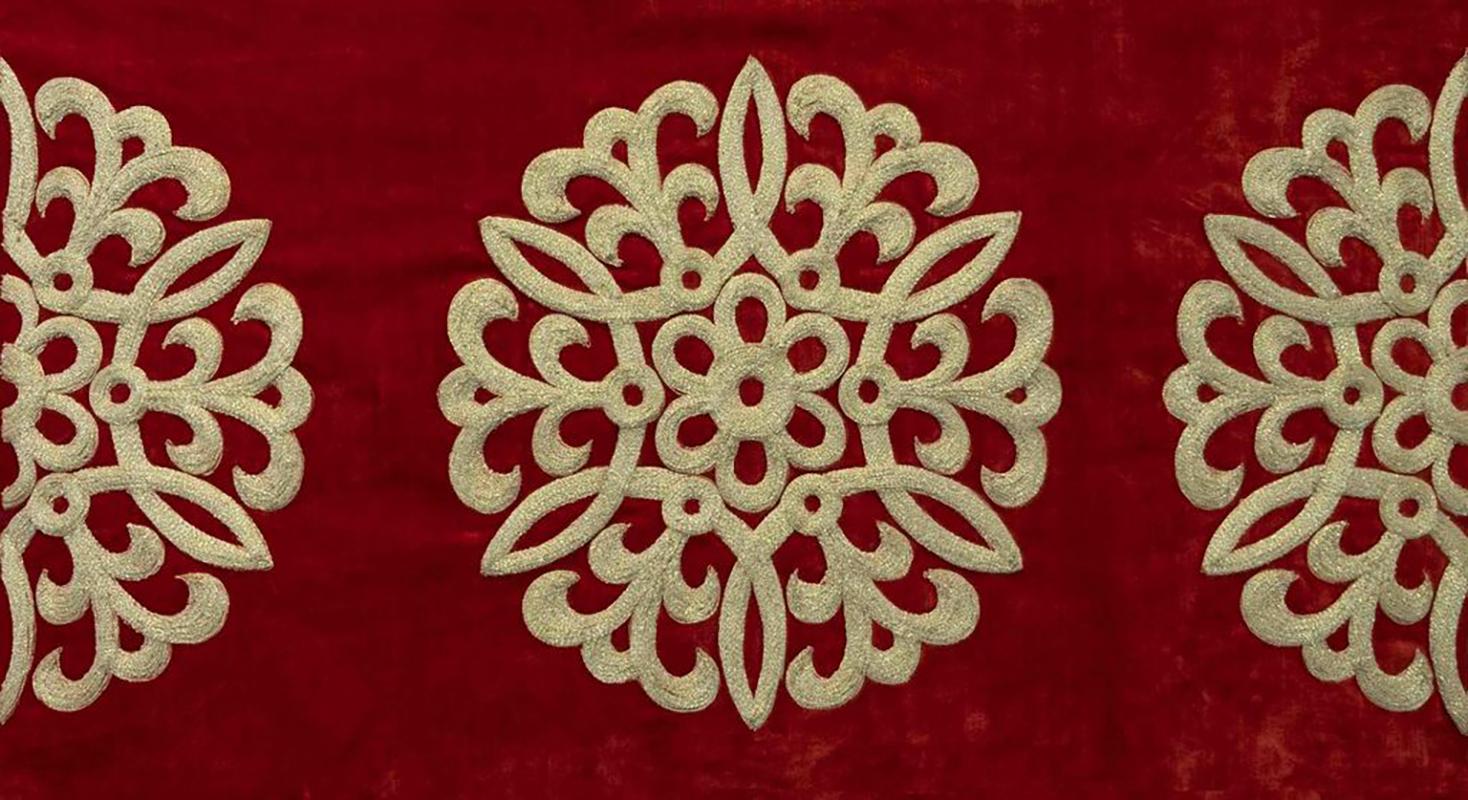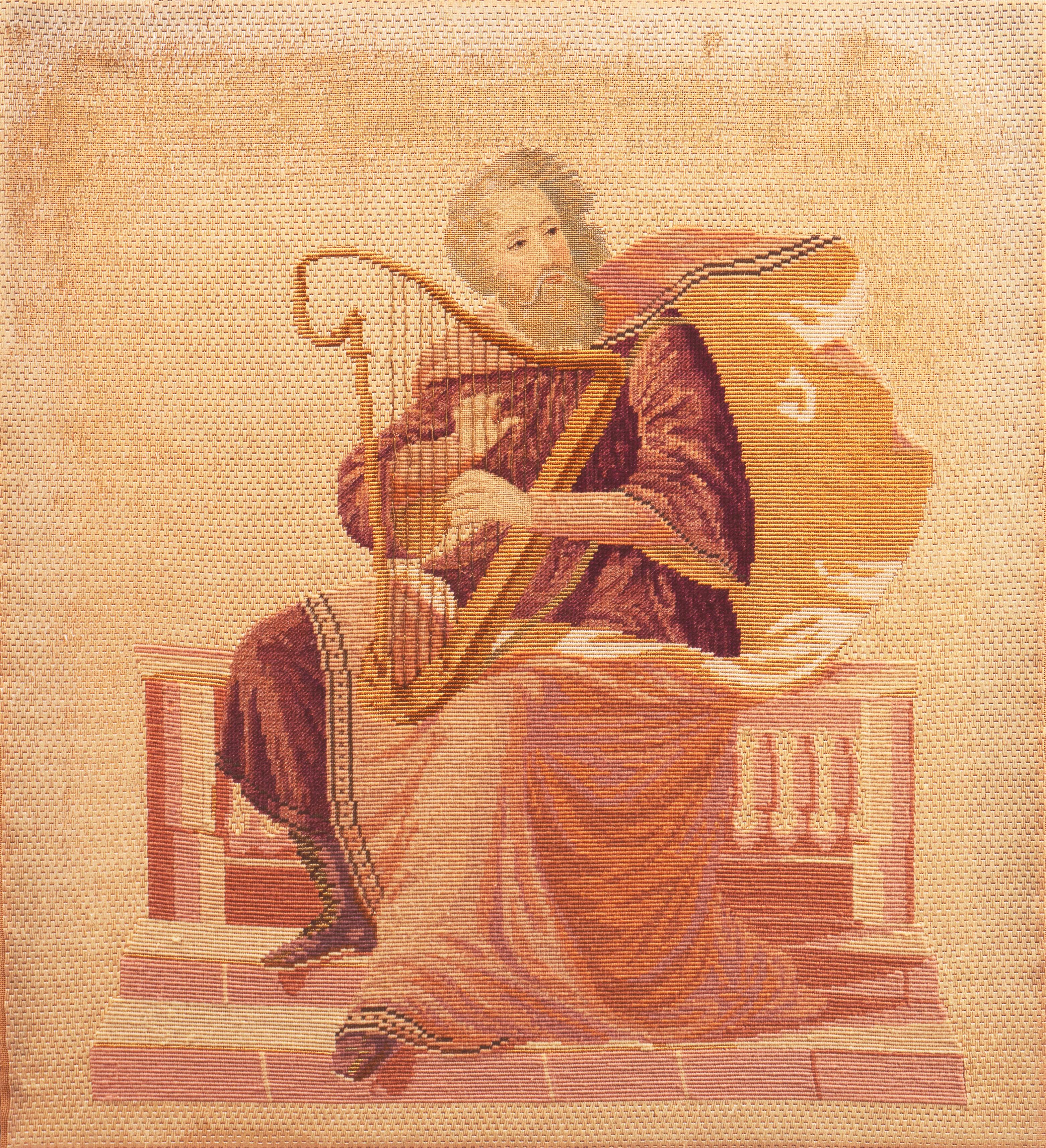Items Similar to Embroidered Roundels of Turtles
Want more images or videos?
Request additional images or videos from the seller
1 of 5
UnknownEmbroidered Roundels of Turtles
About the Item
A silk and gold thread embroidery of titles. Japan's textile industry was one of the first to adopt Western science and technology, and thus the Meiji era produced some of the highest quality silk textiles. The engravings of oil paintings inspired the embroideries, with the artist of the painting and the artist at the textile factory maintaining a close relationship. Japanese embroidery technique goes back more than one thousand years. It originated in China and was eventually introduced to Japan by Korean artisans; around the same time Buddhism entered Japan. In Japan, colored silks were embroidered with long soft stitches in untwisted silk threads. Flowers, birds, bold flowing lines, and abstract motifs are common in Japanese textiles, and the designs achieve a feeling of calm restraint through their spacious distribution. Also characteristic of Japanese textiles is the use of gold and silver thread. The Japanese developed a special method of creating metal threads, in which a layer of gold or silver was deposited on to rice paper, which was then cut into fine strips and wrapped around a thread core.
- Dimensions:Height: 21 in (53.34 cm)Width: 32 in (81.28 cm)
- Medium:
- Period:
- Condition:
- Gallery Location:Palm Desert, CA
- Reference Number:
About the Seller
4.8
Recognized Seller
These prestigious sellers are industry leaders and represent the highest echelon for item quality and design.
Established in 1996
1stDibs seller since 2011
101 sales on 1stDibs
Typical response time: 5 hours
- ShippingRetrieving quote...Ships From: Palm Desert, CA
- Return PolicyA return for this item may be initiated within 7 days of delivery.
More From This SellerView All
- Trumpet Flower and Nap #101By Kaoru MansourLocated in Palm Desert, CAA painting by Kaoru Mansour. "Trumpet Flower and Nap #101" is a contemporary mixed media piece, acrylic, paper, 22K gold leaf, pen, glitter, and thread ...Category
21st Century and Contemporary Contemporary Still-life Paintings
MaterialsGold Leaf
- Fukusa, Pair of LobstersLocated in Palm Desert, CAA silk embroidery by an unknown Japanese artist. “Fukusa, Pair of Lobsters” is from the Meiji Period and in golds and blues. The artwork is unsigned. Provenance: Private Collection, Palm Springs Heather James Fine Art, Palm DesertCategory
Late 19th Century Tribal More Art
MaterialsSilk
- Figure of a Beauty, Japan, Edo PeriodLocated in Palm Desert, CAA Japanese embroidery from the Edo Period. “Figure of a Beauty” is a portrait embroidery, silk and gold thread in golds and grays. Provenance: Priv...Category
18th Century Edo More Art
MaterialsSilk
- Dog and Wagon Embroidery, JapanLocated in Palm Desert, CAA Japanese Embroidery featuring a dog and wagon, silk and gold thread embroidery by an unknown artist from c. 1890. The artwork is unsigned. Provenance: Private Collection, Los Angeles; Heather James...Category
Late 19th Century Tribal More Art
MaterialsSilk
- Porter Series: Carte L'Europe (Shower Woman)By William KentridgeLocated in Palm Desert, CA"Porter Series: Carte L'Europe (Shower Woman)" is a tapestry by South African artist William Kentridge. It is edition 1 of 5 (plus 2 APs) and signed verso "W. Kentridge". William Kentridge is a South African graphic artist, filmmaker, and theatre arts activist especially noted for a sequence of hand-drawn animated films he produced during the 1990s. The pungent humanism he revealed in these and other works echoed a larger European tradition of artists such as Honoré Daumier, Francisco de Goya, and William Hogarth. Kentridge, whose father was a noted antiapartheid lawyer, attended the University of Witwatersrand in Johannesburg (1973–76) and the now-defunct Johannesburg Art Foundation (1976–78). At various times in the 1970s and ’80s, he worked as an actor, playwright, set designer, and theatrical director, and he studied mime and theatre in Paris in the early 1980s. In 1992 he began an ongoing collaboration involving multimedia performances with Handspring Puppet Theatre (founded 1981) in Cape Town. As is clear from both his early training and his later artistic output, Kentridge’s interest in the visual arts was rooted in its connection with the theatrical arts. The narrative structure and character development in his films reflect this connection. While Kentridge pursued several avenues as an artist, at the centre of his work was a sequence of short animated films. To produce them, he made a rough charcoal drawing, photographed it, altered the drawing slightly, photographed it again, and so on. Kentridge’s original drawings are often completely effaced by their successors. Many of these films—including Johannesburg, 2nd Greatest City After Paris (1989) and Felix in Exile (1994)—follow the fortunes of the greedy capitalist Soho Eckstein and his alter ego, the sensitive and artistic Felix Teitelbaum. They present modern South Africa as reflective of the spiritual, ecological, and emotional crises of late capitalism. Kentridge later established himself as a consummate figure in the performing arts, particularly for his innovative stagings of the operas The Nose (2010) and Lulu (2015) at New York’s Metropolitan Opera and Wozzeck (2017) at the Salzburg Festival...Category
21st Century and Contemporary More Art
MaterialsTapestry, Silk
- Dutiful Son/Japanese FukusaLocated in Palm Desert, CAJapanese Fukusa Silk embroidery with gold threadCategory
19th Century More Art
MaterialsSilk
You May Also Like
- Tree of Life - Embroidered Tapestry Wall HangingLocated in Asheville, NCTree of Life One ancient mythical symbol appears across various cultures as the esoteric Tree of Life. The Tree represents life's abundance and immortality. The cosmic mountain is often depicted as the highest point on earth where heaven and earth meet, where Gods dwell; the Tree stands atop it. Specific trees are held sacred and worshipped as the Tree of Life by the different cultures, and it does not bode well to cut the Peepal in India, Bodhi (Peepal) in Buddhist countries, Cyprus in Iran etc. About: "Art is just perception. The first glance is an emotion, your emotion. The title of the canvas is read after that."- Shabbir Merchant...Category
2010s Other Art Style Mixed Media
MaterialsMetal, Gold
- Brocade: Bootas (Motifs) - Embroidered Tapestry Wall HangingLocated in Asheville, NCBrocade: The royal courts of the Maharajas of India were symbols of extravagance. The opulent Brocade or Zari textile was used lavishly to ornament the interiors. Brocade is a heavy weight drape, woven in intricate raised patterns of motifs or all over floral scrolls. What grants this fabric its royal stature is the use of gold and silver metal threads to weave the designs. These wall panels depict the rich affluent luxury of the Brocade. Gold corded thread embroidered on deep plush velvet creates raised patterns. The artwork is designed to exaggerate the opulence. A note on handmade: A handmade product is always appealing due to the irregularities in its workmanship. This is what sets it apart from machine made or computerized; the perfection they offer feels synthetic or artificial. Especially when one speaks of art and craft. These wall panels are works of hand worked embroideries. Imperfections such as an occasional puckering of the base material are expected with the kind of embroidery stitches used. You are assured these artworks are embroidered by highly skilled artisans (it is not possible for craftsmen of lesser experience to create these pieces) The materials used for the embroideries are of superior quality only. About: Shabbir Merchant...Category
2010s Other Art Style Mixed Media
MaterialsMetal, Gold
- Jamavar: Ecru - Embroidered Tapestry Wall HangingLocated in Asheville, NCJamavar The Jamavar of Kashmir is an exquisite heritage textile of India. The original Jamavar was a yard-long shawl of pashmina wool with delicate patterns handwoven in multicolored silk weft threads. Its authentic designs are finely intricate, imparting gentle aristocracy with its most outstanding and popular motif being the elongated teardrop, originally called 'buteh'. The 'buteh' is what one now recognizes as the 'paisley'. These artworks are compositions of the timeless 'buteh' of the Jamavar. The wall panels are embroidered with fine thread cords couched along the pattern. A note on handmade: A handmade product is always appealing due to the irregularities in its workmanship. This is what sets it apart from machine made or computerized; the perfection they offer feels synthetic or artificial. Especially when one speaks of art and craft. These wall panels are works of hand worked embroideries. Imperfections such as an occasional puckering of the base material are expected with the kind of embroidery stitches used. You are assured these artworks are embroidered by highly skilled artisans (it is not possible for craftsmen of lesser experience to create these pieces) The materials used for the embroideries are of superior quality only. About: Shabbir Merchant...Category
2010s Other Art Style Mixed Media
MaterialsGold, Metal
- 'Homer', 19th Century Figural Embroidery showing the Blind Poet Playing his LyreLocated in Santa Cruz, CAA substantial mid-nineteenth century figural embroidery showing the bard with a full beard playing a lyre, seated on a classical colonnade and gazin...Category
Mid-19th Century More Art
MaterialsThread, Wool, Silk
- Jaali: Phulwari (Flower Garden) - Embroidered Tapestry Wall HangingLocated in Asheville, NCJaali: Jaali' of Urdu origin meaning netting, is an ornamental open work originally crafted on wood, metal and stone for interiors. A significant feature of Indo-Islamic art, the Jaali is an intricate pattern ranging from delicate trellises to complex floral layouts. The wall panels depict the interlacing design of the Jaali in mid earth tones on silk. The compositions of flowers and the paisley are embroidered in thread with subtle highlightes of shine. A note on handmade: A handmade product is always appealing due to the irregularities in its workmanship. This is what sets it apart from machine made or computerized; the perfection they offer feels synthetic or artificial. Especially when one speaks of art and craft. These wall panels are works of hand worked embroideries. Imperfections such as an occasional puckering of the base material are expected with the kind of embroidery stitches used. You are assured these artworks are embroidered by highly skilled artisans (it is not possible for craftsmen of lesser experience to create these pieces) The materials used for the embroideries are of superior quality only. About: Shabbir Merchant...Category
2010s Other Art Style Mixed Media
MaterialsFabric, Tapestry, Thread, Yarn, Textile, Silk
- Jaal - Kairi (Paisley) - Velvet Edition - Embroidered Tapestry Wall HangingLocated in Asheville, NCJaali: Jaali' of Urdu origin meaning netting, is an ornamental open work originally crafted on wood, metal and stone for interiors. A significant feature of Indo-Islamic art, the Jaali is an intricate pattern ranging from delicate trellises to complex floral layouts. The wall panels depict the interlacing design of the Jaali in mid earth tones on silk. The compositions of flowers and the paisley are embroidered in thread with subtle highlightes of shine. A note on handmade: A handmade product is always appealing due to the irregularities in its workmanship. This is what sets it apart from machine made or computerized; the perfection they offer feels synthetic or artificial. Especially when one speaks of art and craft. These wall panels are works of hand worked embroideries. Imperfections such as an occasional puckering of the base material are expected with the kind of embroidery stitches used. You are assured these artworks are embroidered by highly skilled artisans (it is not possible for craftsmen of lesser experience to create these pieces) The materials used for the embroideries are of superior quality only. About: Shabbir Merchant...Category
2010s Other Art Style Mixed Media
MaterialsFabric, Tapestry, Thread, Textile, Yarn, Silk
Recently Viewed
View AllMore Ways To Browse
Antique Embroidered
Antique Embroider
Thread Embroidery
Embroidery Techniques
Antique Silk Thread
Embroidered Metal
Turtle Art
Science And Technology
Bird Silk Art
Gold Turtle
Japanese Embroidered
Japanes Embroidery
Japanese Embroidery
Turtle Back
Gold Thread Embroidery
Antique Embroidery Thread
Antique Gold Embroidery
Antique Japanese Textile





